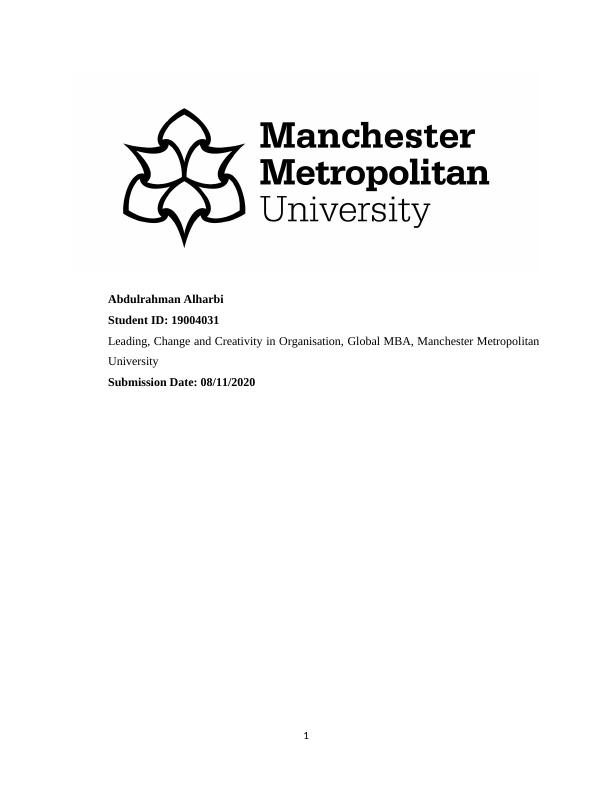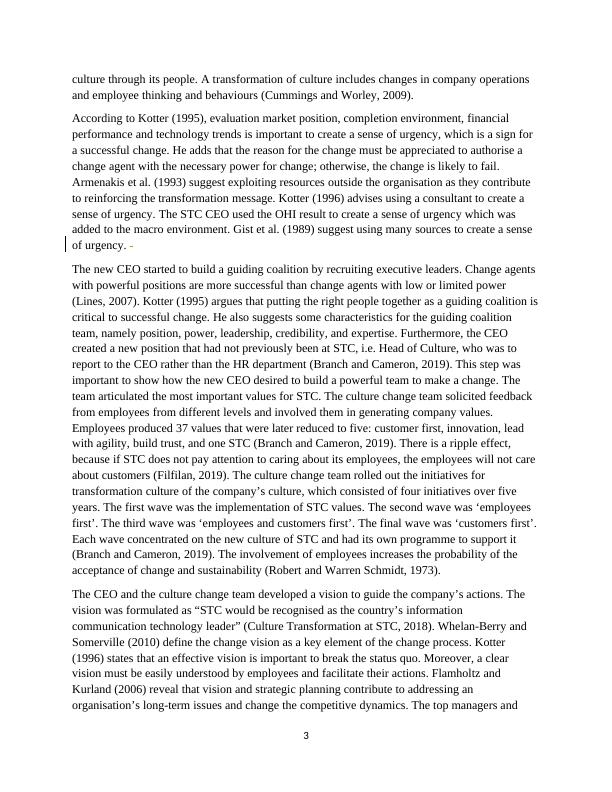Ask a question from expert
(PDF) Managing creativity in change
11 Pages5110 Words55 Views
Added on 2021-03-15
(PDF) Managing creativity in change
Added on 2021-03-15
BookmarkShareRelated Documents
Abdulrahman Alharbi Student ID: 19004031Leading, Change and Creativity in Organisation, Global MBA, Manchester MetropolitanUniversitySubmission Date: 08/11/20201

The telecommunications and information technology industry are growing fast and is always subject to ongoing change, responding to globalisation, technology, and external factors. Harker (1996: 1) posits that “a tidal wave of change is headed towards the telecommunications industry”. Furthermore, the change that is taking place in the telecommunications and information technology industry is reshaping the social, political, and economic environment for nearly every person on the planet (Harker,1996). For example, it affects methods of communication, computing, and information, and doing business. Only companies that are awareof and prepared for revolution will survive. Saudi Telecom Company (STC) has a market capitalisation of $21 billion; it is considered the biggest company in the Middle East and is ranked 20th globally in terms of revenue, financial net profit and human resources (Saudi Press Agency, 2018). STC has more than 15,000 employees and its services include post-paid, card telephone, pre-paid, video streaming demand 3 and 4 G. STC has taken bold steps to keep its activities abreast with the dynamic nature of the industry. The changes that have occurred in STCis imperative in line with the external and internal environments. STC was privatised in 1998 andhas been the most successful privatisation in Saudi Arabia; the company has enjoyed a monopolyof telecommunications in Saudi Arabia due to regulations not allowing other telecommunicationscompanies to enter the local market. STC generates 85% of its revenue from the local market. However, it has expanded its presence in foreign countries, such as Kuwait, Bahrain, Turkey, and South Africa, to obtain half its revenue from abroad (Reuters, 2013). The Saudi government holds 70% of STC shares and the rest are held by private and institutionalinvestors. However, in 2002 Saudi authority gave a license to Etihad Etisalat Company to operate in the local market, and in 2007 a licence was given to a third operator, Zain Company. These companies could operate well and benefit from the boom in mobile services. STC lost approximately 40% of its share to Etihad Etisalat Company (Branch and Cameron, 2008) and thecost of operation increased. Paul Director of Sydney – based telecommunication advised STC to reduce cost to stay competitive and profitable (Reuters, 2013). Furthermore, STC’s foreign investment did not meet board expectations (Reuters, 2013). Mr Biyari, who was later assigned as STC’s Chief Executive Officer (CEO) said, “When I joined in 2013, the organisation was verycomplex – telecom is complex. People were extremely demotivated because they were not clear on exactly what was going to happen. Some were scared. Many of the top management decided to leave or were let go. There was a bit of a management vacuum. The time between mid-2013 tothe latter part of 2014 or early 2015 was a time of changing...a period of stabilization” (Branch and Cameron, 2019: 2). Therefore, something had to change at STC.The board chairman assigned Mr Biyari as CEO, who deployed McKinsey & Company’s Organizational Health Index (OHI) to establish a baseline of the company’s culture, health, and ability to succeed. The OHI result was disappointing. Only 19% of employees participated; it was one of the worst-performing companies that used it the metric. Moreover, when Mr Biyari took over the CEO position at STC, the external environment was challenging; the oil price was declining quickly, which was affecting customer spending in Saudi Arabia (STC Culture ChangeJourney, 2018). The OHI and external environment motivated the new CEO to transform STC’s 2

culture through its people. A transformation of culture includes changes in company operations and employee thinking and behaviours (Cummings and Worley, 2009).According to Kotter (1995), evaluation market position, completion environment, financial performance and technology trends is important to create a sense of urgency, which is a sign for a successful change. He adds that the reason for the change must be appreciated to authorise a change agent with the necessary power for change; otherwise, the change is likely to fail. Armenakis et al. (1993) suggest exploiting resources outside the organisation as they contribute to reinforcing the transformation message. Kotter (1996) advises using a consultant to create a sense of urgency. The STC CEO used the OHI result to create a sense of urgency which was added to the macro environment. Gist et al. (1989) suggest using many sources to create a sense of urgency. The new CEO started to build a guiding coalition by recruiting executive leaders. Change agents with powerful positions are more successful than change agents with low or limited power (Lines, 2007). Kotter (1995) argues that putting the right people together as a guiding coalition iscritical to successful change. He also suggests some characteristics for the guiding coalition team, namely position, power, leadership, credibility, and expertise. Furthermore, the CEO created a new position that had not previously been at STC, i.e. Head of Culture, who was to report to the CEO rather than the HR department (Branch and Cameron, 2019). This step was important to show how the new CEO desired to build a powerful team to make a change. The team articulated the most important values for STC. The culture change team solicited feedback from employees from different levels and involved them in generating company values. Employees produced 37 values that were later reduced to five: customer first, innovation, lead with agility, build trust, and one STC (Branch and Cameron, 2019). There is a ripple effect, because if STC does not pay attention to caring about its employees, the employees will not care about customers (Filfilan, 2019). The culture change team rolled out the initiatives for transformation culture of the company’s culture, which consisted of four initiatives over five years. The first wave was the implementation of STC values. The second wave was ‘employees first’. The third wave was ‘employees and customers first’. The final wave was ‘customers first’. Each wave concentrated on the new culture of STC and had its own programme to support it (Branch and Cameron, 2019). The involvement of employees increases the probability of the acceptance of change and sustainability (Robert and Warren Schmidt, 1973). The CEO and the culture change team developed a vision to guide the company’s actions. The vision was formulated as “STC would be recognised as the country’s information communication technology leader” (Culture Transformation at STC, 2018). Whelan-Berry and Somerville (2010) define the change vision as a key element of the change process. Kotter (1996) states that an effective vision is important to break the status quo. Moreover, a clear vision must be easily understood by employees and facilitate their actions. Flamholtz and Kurland (2006) reveal that vision and strategic planning contribute to addressing an organisation’s long-term issues and change the competitive dynamics. The top managers and 3

executives at STC were encouraged to visit employees at workplaces, such as call centres and STC shops, to listen to both customers and employees. Various meetings and gatherings were held; for example, 22 group discussions and 47 workshops based on the OHI results were organised. The STC culture change team deployed several ways to communicate the change vision. Kotter (1996) suggests using several ways to communicate, such as two-way communication and providing employees with significant information through their immediate supervisors or managers. Communication plays an important role in the success of the change and encourages employees to engage with the change (Bordia et al., 2004). There is a clear relationship between high quality communication and reduction of anxiety. Employees who are satisfied with management communication see personal opportunities and have a positive reaction toward the change (Nielsen and van Selm, 2008). The STC culture change team organised dozens of meetings with the top hundred employees at STC to brainstorm ideas for culture change, then themeetings included the top four hundred employees, then the top thousand employees. Furthermore, the event “Breakfast with the CEO” allowed ordinary employees to meet with the CEO (Branch and Cameron, 2019). This was important to ensure both management and employees were on the right track (Reichers et al., 1997; Marks, 2007). The culture change team at STC designed a training programme for managers (Branch and Cameron, 2019). This step was important to increase the ownership of the change among employees to maximise the likelihood of the change being implemented successfully. According to Kotter at al. (2007), one of the major elements playing a role in empowering employees is training. Denton (1994) emphasises that training contributes to building a sense of responsibility and empowers employees. Empowering employees is important for successful transformation in an organisation (Paper et al., 2001). Empowerment also plays a significant role in dealing with obstacles. The STC culture change team tried to motivate employees to change by giving them autonomy. For example, employees were selected randomly from different levels across Saudi Arabia to discuss their points of view with the CEO. These meetings had no agenda to encourageemployees to speak their minds (Branch and Cameron, 2019). Pink (2011) includes autonomy, mastery and purpose in his list of key motivators.The culture change team tried to gain some short-term wins Kotter (1996) believes that short-term wins provide an opportunity of the real test for the vision and adjustment. Short-term wins can help to reduce the difficulties of a change and reinforce the change vision in an employee’s mindset (Drtina et al., 1996). Leaders need to show that the new way is effective and long-term objectives are achievable; therefore, short-term gains are important (Kotter, 1995). Pfeifer et al. (2005) maintain that show the credibility of vision and strategy through the use of measurable result in the primary objective for gathering succussed. The purpose of executives visiting workplaces was to ensure that top management listened to employees; STC desired to improve the work environment. It also designed recognition and rewards for excellence in customer experience (Filfilan, 2017). These short gains should be used to deal with other issues that need 4

End of preview
Want to access all the pages? Upload your documents or become a member.
Related Documents
Financial Decision Making: Analysis of SAUDI TELECOM CO and Competitorslg...
|34
|7040
|402